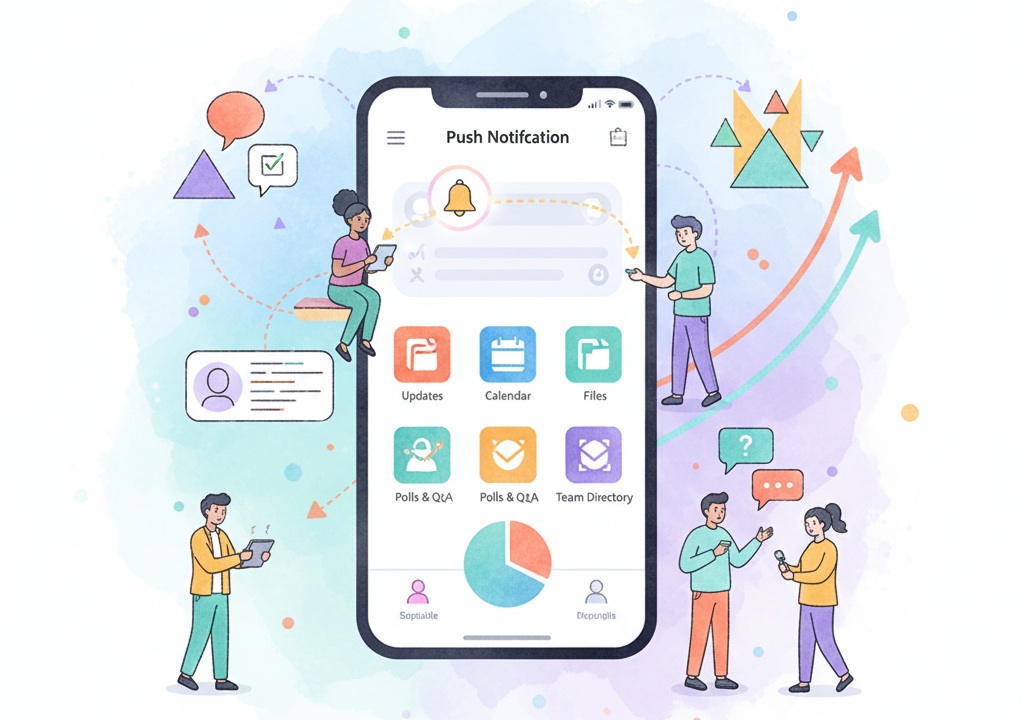Why do intranets miss the mark?
Intranets were once the gold standard for internal communication—a single place for employees to find updates, policies, and documents. But let’s be honest: most intranets today are clunky, outdated, and rarely used.
Employees expect the same seamless, mobile-first experiences at work that they enjoy in their daily lives. Instead, they’re met with buried logins, confusing navigation, and stale content. The result? Missed updates, disengagement, and frustration.
One Yapp teammate summed it up perfectly: “If employees need a password they don’t remember and a desktop to access it, they won’t use it. And if they won’t use it, it fails.”
The truth is, intranets were built for a different era—when employees sat at desks, worked nine-to-five, and checked internal portals regularly. Today’s workforce is mobile, hybrid, and expects on-demand access to information. Traditional intranets can’t keep up.
Worse, they’ve become digital filing cabinets instead of communication engines. When information is buried in endless links or outdated folders, employees stop searching altogether. The more complicated the system, the faster engagement drops—and the harder it becomes to rebuild trust in internal communication.
What happens when intranets fail?
When intranets stop working, communication breakdown follows. The consequences show up in every department:
- Low adoption: Tools only drive value if people actually use them.
- Information silos: HQ stays informed while field teams are left guessing.
- High costs: IT teams waste time maintaining outdated systems.
- Disengaged employees: When tools feel irrelevant, staff stop listening altogether.
Take Cole Haan, for example. Their retail workforce struggled to stay connected to HQ. Associates weren’t checking the intranet, missing critical campaign updates and training materials. Information was fragmented across email chains and paper memos.
By shifting to a mobile-first internal app built with Yapp, Cole Haan replaced confusion with clarity. The new app became the go-to hub for updates, resources, and training—something employees actually wanted to use. Within weeks, engagement and consistency across stores skyrocketed.
As explained in our guide on transforming internal communication, companies that go mobile report faster adoption, higher satisfaction, and lower communication costs.
How do internal apps fix communication gaps?
Replacing the intranet with a mobile event app or internal communication app solves problems that traditional systems can’t. These apps provide an intuitive, mobile-first experience built around accessibility and engagement—not complexity.
Here’s how internal apps fill the gaps:
- Instant access: No clunky logins or VPNs—just tap and go.
- Push notifications: Time-sensitive updates reach everyone instantly.
- Personalization: Tailor content to departments, roles, or locations.
- Interactivity: Use polls, Q&A, and social feeds for two-way communication.
- Scalability: Start with one team and expand organization-wide.
These features transform communication from static to dynamic. Instead of sending one-way messages, leaders can spark conversation and collaboration.
A Yapp teammate explained it this way: “The magic isn’t just replacing the intranet—it’s creating an app employees actually want to open.”
That engagement drives adoption, which drives impact. When teams consistently access updates and training on a platform they enjoy using, communication becomes part of their daily workflow.
And it doesn’t stop there. Internal apps provide real-time analytics—showing who’s engaging, what content performs best, and where communication gaps still exist. Leadership teams gain insights they never had with intranets buried behind IT walls. Instead of guessing what employees read, they know.
What’s the path forward?
The future of internal communication is mobile, flexible, and human-centered. Instead of clunky portals built for IT, companies are turning to platforms employees love to use.
Cole Haan’s transition to Yapp is a perfect example. Their internal app consolidated everything—from campaign materials and training videos to store announcements—into one branded hub. Store managers could access content on the floor, share feedback, and celebrate team wins, all from their phones.
The results were immediate: stronger brand alignment, faster training rollout, and higher employee morale. Teams that once felt disconnected now felt part of a unified mission.
And Cole Haan isn’t alone. Many organizations—spanning retail, education, and enterprise—are replacing traditional intranets with internal communication apps to streamline operations and connect distributed teams.
The data backs it up: companies using mobile-first internal communication see up to 3x higher engagement than those relying on intranets. That’s not just better communication—it’s better business.
An internal app also fosters transparency. Employees see leadership updates in real time, recognize achievements across departments, and feel included in company growth. It’s more than a digital shift—it’s a cultural one.
Stop settling for broken intranets
Your intranet shouldn’t be a graveyard for outdated PDFs and forgotten posts. Employees deserve a tool that matches how they actually work—mobile, intuitive, and immediate.
Stronger communication builds stronger teams. An internal app doesn’t just replace the intranet—it creates a culture of clarity, connection, and collaboration.
Ready to make the shift? With Yapp, you can build your own communication app in minutes—no coding, no IT bottlenecks, no frustration.
Start your free trial and see why forward-thinking teams are replacing intranets with Yapp’s simple, mobile-first platform.










